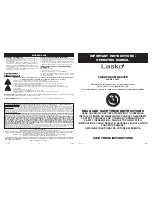
7
● Use only implements recommended by the manufacturer for defrosting or cleaning
● Do not perforate any of the components in the refrigerant circuit. Refrigerant gas may be
odorless
● Use care when storing the appliance to prevent mechanical faults.
● Only persons authorized by an accredited agency certifying their competence to handle
refrigerants in compliance with sector legislation should work on refrigerant circuit.
● All repairs must be carried out in accordance with the manufacturer’s recommendati ons.
● Maintenance and repairs requiring the assistance of other qualified personnel must be
carried out under the supervision of specialists in the use of inflammable refrigerants.
● Do not perforate any of the components in the refrigerant circuit. Refrigerant gas may be
odourless
Additional warning for appliance with R290 refrigerant gas (refer to the rating plate for the type
of refrigerant gas used)
CAUTION ON FIRE READ THE MAUAL CAREFULLY BEFORE
USING THE APPLIANCE
R290 refrigerant gas complies with European environmental directives. This appliance
contains approximately 235 g of R290 refrigerant gas. Appliance shall be installed, operated
and stored in a room with a floor area larger than 11.7 m
2
.
Instruction, Repairing Appliances Containing R 290
1. Checking the area
Prior to beginning work on systems containing flammable refrigerants, safety checks are
necessary to ensure that the risk of ignition is minimised. For repair to the refrigerating
system, the following precaution shall be completed prior to conducting work on the system.
2. Work procedure
Work must be carried out according to a verified procedure so as to minimise the risk of a
flammable gas or vapour being present while the work is being performed.
3. General work area
All maintenance staff and others working in the local area shall be instructed on the nature of
work being carried out. Work in confined spaces shall be avoided.
4. Checking for presence of refrigerant
The area shall be checked with an appropriate refrigerant detector prior to and during work,
to ensure the technician is aware of potentially toxic or flammable atmospheres. Ensure that
the leak detection equipment being used is suitable for use with all applicable refrigerants, i.e.
nonsparking, adequately sealed or intrinsically safe.








































